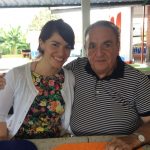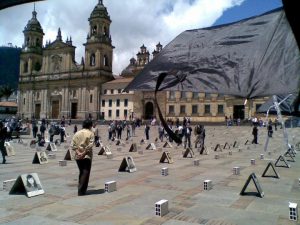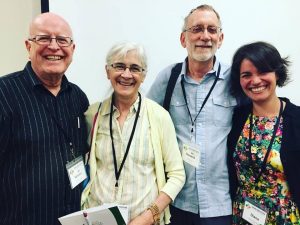In early October, Diana Tovar nearly missed a meeting with colleagues to talk about her new position as the Center for Justice and Peacebuilding’s new peacebuilding network coordinator. In a whirlwind trip to Washington D.C., she joined other expatriates for a vigil after some voters in her native Colombia rejected the peace agreement between the government and the Revolutionary Armed Forces of Colombia (known as FARC).
Drawn to peacebuilding work since she was a child, Tovar will help connect alumni around the world. She’ll also help current students and faculty connect with alumni.
Like most CJP students, she brings a host of experiences to her academic work, her peacebuilding practice and her current position.
Shaped by violence
Her father, “a very big motivator of my work,” was kidnapped twice by the Revolutionary Armed Forces of Colombia. After the second kidnapping, he moved with his family to Romania for security reasons, where he was a diplomat in Bucharest. Tovar, then 13, and her three younger brothers attended a French school.

Her family returned to Colombia around her 18th birthday, and she enrolled at Pontificia Javeriana University to study political science, conflict analysis and resolution, and research for peace.
There, a class on consensus building proved to be pivotal, as well as reading CJP co-founder John Paul Lederach’s The Moral Imagination. This sparked what would be her later research interest in the intersections between transitional and restorative justice, and eventually led to her studies at CJP.
A circle-keeper with Chicago youth
A second life-changing event, she says, was an internship with Imagine Chicago, a nonprofit working on civic engagement and community-strengthening. Through Community Justice for Youth Institute, she was introduced to a number of restorative justice practitioners, and trained to be a facilitator of circle processes.
After the summer, Tovar returned to Bogota where she served as project coordinator for a transitional justice project based at Pontificia Javeriana University in collaboration with George Mason University. Colombia’s Victims and Restitution Law of 2011 had just been passed, which “was the first time the government was acknowledging the victims” of decades of internal armed conflict, explains Tovar.

Tovar’s project involved listening to victims who had resettled in Soacha about how their wounds and losses could be redressed. Soacha “is a microcosm of Colombia,” she says, where the country’s refugees – peasant farmers, indigenous people, Afro-Colombians and ex-combatants alike – live in tight quarters.
“That was the first time I really understood that victims and perpetrators had to live together,” says Tovar.
When that project ended, Tovar returned to Illinois, where she interned with the Cook County Juvenile Detention Department. She was moved by her experiences with the Chicago gang youth.
“There I understood … this dichotomy between victims and offenders was something really damaging.” While accountability is necessary, explains Tovar, she saw each offender as both a victim and perpetrator.
Narrowing her focus
In Chicago, Tovar attended a lecture by Professor Carl Stauffer on the intersection of transitional and restorative justice, the topic of her then-in progress thesis.

After graduation from Pontificia Javeriana University, Tovar assisted with several projects, among them a two-month joint project with the Victim’s Unit, in which providers analyzed the collective reparation needs of a community affected by war. Tovar contributed to the self-care component among those who had direct contact with victims. She was then was hired by UNICEF as a consultant, a job which appeared at the right time among personal upheaval, but which eventually led her to graduate school.
“Deep, deep in my heart, I knew that I only wanted to study peacebuilding,” she says.
At CJP, Tovar is pleased to be among “amazing and incredible people who go back to their communities and do amazing work,” she says. “When we come here, we have a shared value, and it’s wholeness, the interconnectedness that makes us responsible to our local and global neighbors.”
